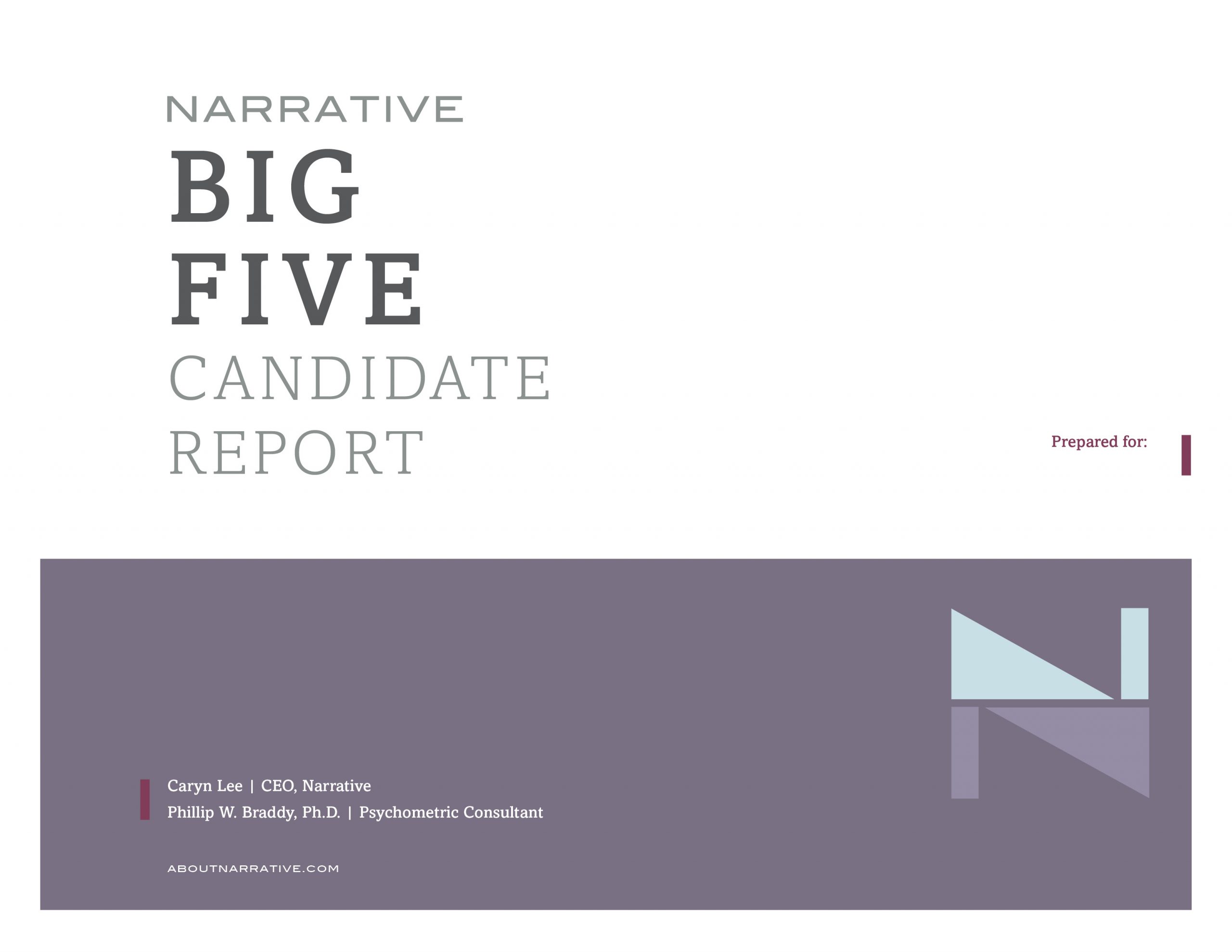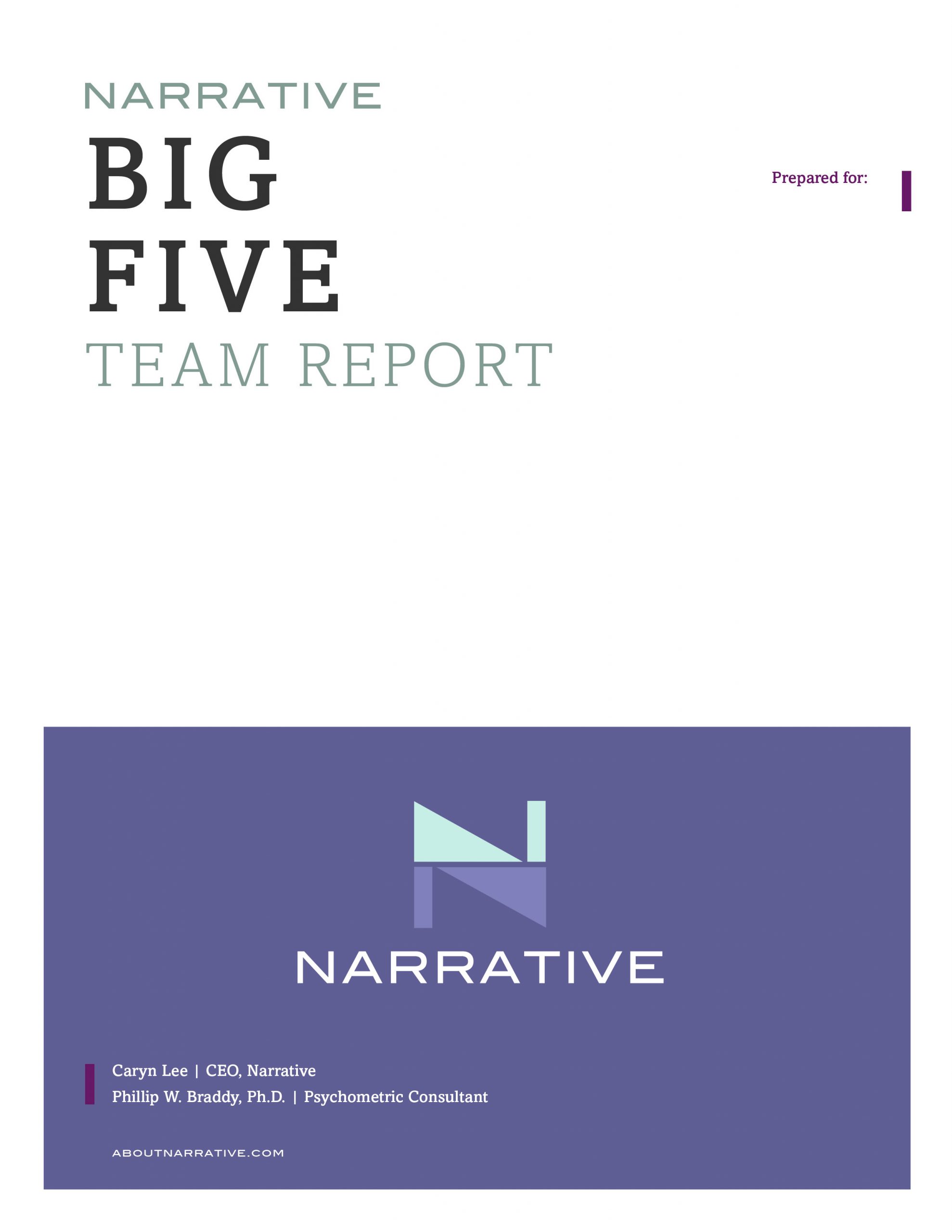THE NARRATIVE BIG FIVE ASSESSMENT & REPORT
The Narrative Big Five Assessment and Report are based on the Five Factor Model of Personality. The model’s beginnings date back to the 1930’s and, where most personality assessments such as the DISC or MBTI are based on psychological theory, the Five Factor Model is based on empirical data.
Today, there are numerous assessments that are based on the Five Factor Model, most of which include five super-traits – the names of which vary from assessment to assessment – and sub-traits that fall under each super-trait.
Narrative has developed our own proprietary Big Five Assessment, based on the Five Factor Model, which measures the five super traits listed below as well as 23 sub-traits. In total, Narrative’s Big Five Personality Assessment includes 129 items which are completed on a scale of 1 to 5 (strongly disagree to strongly agree) scale rating.
When assessing personality, it is important to remember that there is no “good” or “bad” score. Instead, the Narrative Big Five Assessment looks at the scale as an indicator of strengths. A score may present a strength or challenge, depending on the situation. Just because an individual scores on the left end of the resilience scale does not mean that they are unable to manage stress, rather we observe that those scoring left on the resilience scale are often excellent in customer-service roles where they take the concerns and experience of the customer very seriously. And, where someone may score far-right on the resilience scale, indicating a calm, confident and optimistic personality, they may be less suited to a customer facing role and more suited for positions requiring rational thought – e.g. a pilot or surgeon.
Learn more about the Narrative Big Five Assessment through our webinar Personality at Work: Five Factors of Strength featuring Caryn Lee and
Dr. Cris Wildermuth.
Resilience
Resilience, and its sub-traits, measures the degree to which someone manages stress.
Individuals that score on the left end of the scale indicate a higher frequency of stress and anxiety and may require time for introspection before moving into problem-solving. These individuals are often successful in customer service roles and demonstrate caring personalities.
Conversely, an individual scoring on the far right of the Resilience scale reveals a personality that is generally optimistic and moves to problem-solving mode quickly. However, their challenge is that they may be viewed by others as aloof.
Extraversion
Extraversion defines how much energy someone has for interacting with and influencing people.
People who score on the far left end of the scale indicate a preference for working alone and are often well suited for individual contributor roles, or those based in research or scientific pursuits.
Those who score on the opposite end of the scale indicate a preference for high-levels of interaction; these individuals are often well suited for sales or customer-facing roles.
Openness
Openness measures the degree to which someone enjoys variety and new things.
Those who score on the far left of this scale would indicate a preference for implementation, digging into details, and an individual with specific expert knowledge.
Conversely, individuals scoring on the far right end of the Openness scale indicate an imaginative personality that loves to generate ideas but may not be as adept at translating those ideas into practical steps for execution.
Agreeableness
Agreeableness measures the degree of cooperation with others.
People who score on the far left of the scale tend to enjoy competition, think logically and are independent thinkers – often times these individuals are well suited for sales or leadership roles.
People who score on the opposite end of the spectrum, or far right, tend to be highly cooperative, often putting others first, and may be well suited for service or social work roles.
Conscientiousness
Conscientiousness indicates how disciplined, driven, and structured someone is in their achievement of specific goals.
Individuals who score on the far left end of the conscientiousness scale may be more casual about goal setting but have great multi-tasking skills, contribute diverse perspectives and might be well suited for roles in creative fields or consulting opportunities.
Those scoring at the opposite end of the conscientiousness scale often exhibit personalities that are very driven, focused, organized, and disciplined and find success in leadership and corporate roles.
HOW WE USE THE FIVE FACTOR ASSESSMENT & REPORT
Hiring
The Narrative Big Five Assessment is an incredibly valuable tool in the hiring process as it allows us to profile the job using the assessment to determine the appropriate personality traits, then assess candidates against that target profile. While a candidate’s resume, the interview process and other tools are still essential, the Narrative Big Five Assessment assists in determining great fit. With this method you gain deep insights into exactly what characteristics are ideal for the role and have the tools that help you select the right candidate with the appropriate mix of personality traits. Learn more about Hiring with Narrative.
Team Development & Optimization
When we learn about our teammates’ personalities, behavior, and motivations, we’re better able to communicate and form diverse, inclusive, and high-performance teams. The Narrative Big Five Assessment also aides in team optimization whereby teams can be organized for the optimal personality trait mix based on set goals or work to be accomplished. This method of team development results in teams that are engaged, efficient, and high-performing. Learn more about Team Development & Optimization with Narrative.
Training
The Narrative Big Five Assessment can also be used in training scenarios for sales and customer service organizations to optimize behavioral traits. Or, leverage the assessment and additional solutions as part of your organization-wide training on personality interactions, communication, and conflict resolution. Learn more about Training with Narrative.
Individual Development
Understanding the Narrative Big Five Assessment helps individuals with self-awareness and provides a common language to discuss behavioral and personality differences. By leveraging The Narrative Big Five Assessment individuals not only learn about themselves but can also learn to pick up on personality differences in others, thereby improving understanding and communication. When confronted with an individual on the opposite end of the “spectrum” it’s natural that conflicts may arise; however, simply understanding these various personality traits can smooth tension and help people learn how to work better together by leveraging their respective strengths. Learn more about Individual Development with Narrative.
FIVE FACTOR PERSONALITY ASSESSMENTS & REPORTS
Narrative Big Five Assessment and Report
The Narrative Big Five Assessment is a powerful personality tool used throughout the HR lifecycle. It is based on the Five Factor Model or “Big Five” which is the standard used by psychologists and academics.
Questionnaire: 129 questions that takes 15 minutes to complete
Report: 10 page report with scores on 5 personality super-traits and 23 personality sub-traits with narrative descriptions of the scores
Narrative Big Five Team Report
Once each team member has completed the Narrative Big Five Assessment, then this Team Report contains the whole teams scores on the 5 personality super-traits and 23 personality sub-traits
Narrative Big Five Candidate Report
This is used for Selection. Once a target profile has been created for the job and a candidate has completed the Narrative Big Five Assessment, this report shows the target profile of 23 score ranges, the candidate’s scores and graphically highlights any differences. Yellow shading points out scores within .9 points of the target range and red shading points out scores over 1 point outside the target range. A Job Fit Score of 1 to 10 is provided.
Read sample excerpts from Narrative’s reports.
ADDITIONAL ASSESSMENTS & REPORTS
Motivations Assessment & Report
The Motivations Assessment takes about 15 minutes to complete and the report provides 7 major values with scores and a ranking of priority. This Values Assessment is used in general coaching, career coaching and team training.
360° Feedback Survey & Report
360° feedback surveys are used to get feedback on someone’s performance from their boss, peers, subordinates and others. The report combines the feedback so that the reviewers have anonymity (except for the boss). The report is used by the subject and their coach to determine their main development areas and create a plan for improvement.
Narrative may use other assessments depending on client needs and the project. For example, during Selection, a client may decide that they want to administer an assessment for intelligence or critical thinking or perhaps administer some skills assessments.



